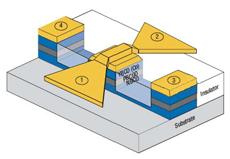Home > Research > “High” Tc Superconductivity, Strongly correlated fermions
Twenty years after its discovery, High Tc Superconductivity remains one of the most challenging subject in condensed matter physics. Not only the mechanism leading to the condensation of electrons in a quantum coherent state up to such high temperature is unknown, but the so called "normal-state", above the critical temperature Tc strongly departs from the standard behavior of metals. It seems that the description of electrons in metal proposed more than 60 years ago by Landau does not apply in these compounds. The ground state in these material would be strongly different than the well-known Fermi Liquid : electronic orders may appear in the charge and/or charge channels. Therefore, pairing may take place on a landscape which would be very different than the one used by BCS in their standard theory of superconductivity.
 Our recent research focused on the superconducting pairing itself, and more specifically the associated fluctuations above Tc. It has been proposed that in High Tc materials, pairing occurs at rather high temperature T* with no long range phase coherence, especially in the underdoped compounds, while a transition to a full quantum condensed state takes place at a lower temperature Tc. Between these two temperatures, a pseudogap develops in the one particle excitations channel as a consequence of the pairing. We have designed a specific experiment to address this question. Namely, we have made a pseudo-Josephson experiment to directly measure the pair susceptibility above Tc in the pseudogap regime of an underdoped cuprate. We did find a signature of fluctuating pairs above Tc, in a rather restricted range of temperature, well below T*. They correspond to the fluctuations expected from the Ginzburg-Landau theory of phase transitions, as already observed in the measurement of paraconductivity above Tc for instance. It seems that no extra fluctuating pairs exist in the pseudogap regime ; the origin of the pseudogap may not be related to superconductivity, but to another competing order.
Our recent research focused on the superconducting pairing itself, and more specifically the associated fluctuations above Tc. It has been proposed that in High Tc materials, pairing occurs at rather high temperature T* with no long range phase coherence, especially in the underdoped compounds, while a transition to a full quantum condensed state takes place at a lower temperature Tc. Between these two temperatures, a pseudogap develops in the one particle excitations channel as a consequence of the pairing. We have designed a specific experiment to address this question. Namely, we have made a pseudo-Josephson experiment to directly measure the pair susceptibility above Tc in the pseudogap regime of an underdoped cuprate. We did find a signature of fluctuating pairs above Tc, in a rather restricted range of temperature, well below T*. They correspond to the fluctuations expected from the Ginzburg-Landau theory of phase transitions, as already observed in the measurement of paraconductivity above Tc for instance. It seems that no extra fluctuating pairs exist in the pseudogap regime ; the origin of the pseudogap may not be related to superconductivity, but to another competing order.